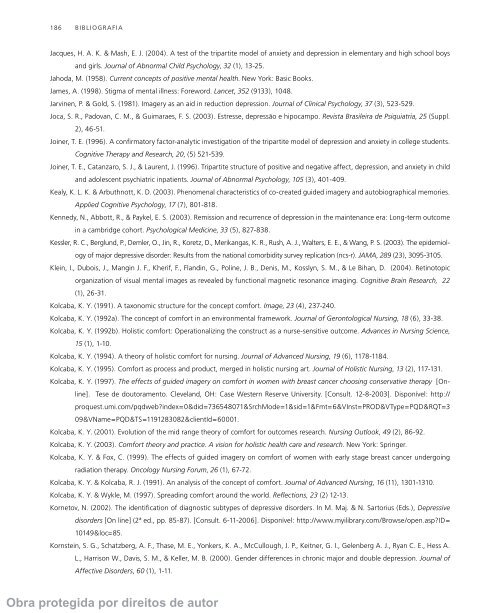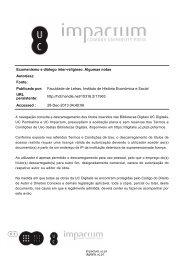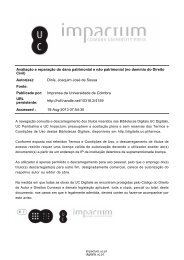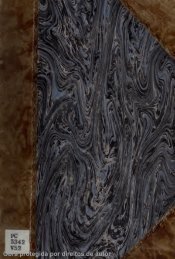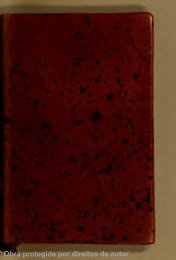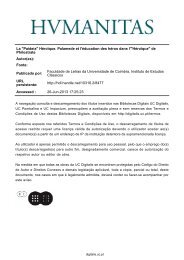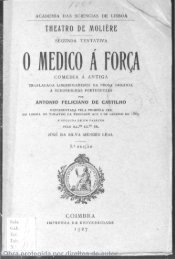Depressão AnsieDADe e stresse - Universidade de Coimbra
Depressão AnsieDADe e stresse - Universidade de Coimbra
Depressão AnsieDADe e stresse - Universidade de Coimbra
You also want an ePaper? Increase the reach of your titles
YUMPU automatically turns print PDFs into web optimized ePapers that Google loves.
186<br />
BiBliOgrafia<br />
Jacques, H. a. K. & mash, E. J. (2004). a test of the tripartite mo<strong>de</strong>l of anxiety and <strong>de</strong>pression in elementary and high school boys<br />
and girls. Journal of Abnormal Child Psychology, 32 (1), 13-25.<br />
Jahoda, m. (1958). Current concepts of positive mental health. new York: basic books.<br />
James, a. (1998). stigma of mental illness: foreword. Lancet, 352 (9133), 1048.<br />
Jarvinen, p. & gold, s. (1981). imagery as an aid in reduction <strong>de</strong>pression. Journal of Clinical Psychology, 37 (3), 523-529.<br />
Joca, s. r., padovan, C. m., & guimaraes, f. s. (2003). E<strong>stresse</strong>, <strong>de</strong>pressão e hipocampo. Revista Brasileira <strong>de</strong> Psiquiatria, 25 (suppl.<br />
2), 46-51.<br />
Joiner, t. E. (1996). a confirmatory factor-analytic investigation of the tripartite mo<strong>de</strong>l of <strong>de</strong>pression and anxiety in college stu<strong>de</strong>nts.<br />
Cognitive Therapy and Research, 20, (5) 521-539.<br />
Joiner, t. E., Catanzaro, s. J., & laurent, J. (1996). tripartite structure of positive and negative affect, <strong>de</strong>pression, and anxiety in child<br />
and adolescent psychiatric inpatients. Journal of Abnormal Psychology, 105 (3), 401-409.<br />
Kealy, K. l. K. & arbuthnott, K. d. (2003). phenomenal characteristics of co-created gui<strong>de</strong>d imagery and autobiographical memories.<br />
Applied Cognitive Psychology, 17 (7), 801-818.<br />
Kennedy, n., abbott, r., & paykel, E. s. (2003). remission and recurrence of <strong>de</strong>pression in the maintenance era: long-term outcome<br />
in a cambridge cohort. Psychological Medicine, 33 (5), 827-838.<br />
Kessler, r. C., berglund, p., <strong>de</strong>mler, o., Jin, r., Koretz, d., merikangas, K. r., rush, a. J., Walters, E. E., & Wang, p. s. (2003). the epi<strong>de</strong>miol-<br />
ogy of major <strong>de</strong>pressive disor<strong>de</strong>r: results from the national comorbidity survey replication (ncs-r). JAMA, 289 (23), 3095-3105.<br />
Klein, i., dubois, J., mangin J. f., Kherif, f., flandin, g., poline, J. b., <strong>de</strong>nis, m., Kosslyn, s. m., & le bihan, d. (2004). retinotopic<br />
organization of visual mental images as revealed by functional magnetic resonance imaging. Cognitive Brain Research, 22<br />
(1), 26-31.<br />
Kolcaba, K. Y. (1991). a taxonomic structure for the concept comfort. Image, 23 (4), 237-240.<br />
Kolcaba, K. Y. (1992a). the concept of comfort in an environmental framework. Journal of Gerontological Nursing, 18 (6), 33-38.<br />
Kolcaba, K. Y. (1992b). Holistic comfort: operationalizing the construct as a nurse-sensitive outcome. Advances in Nursing Science,<br />
15 (1), 1-10.<br />
Kolcaba, K. Y. (1994). a theory of holistic comfort for nursing. Journal of Advanced Nursing, 19 (6), 1178-1184.<br />
Kolcaba, K. Y. (1995). Comfort as process and product, merged in holistic nursing art. Journal of Holistic Nursing, 13 (2), 117-131.<br />
Kolcaba, K. Y. (1997). The effects of gui<strong>de</strong>d imagery on comfort in women with breast cancer choosing conservative therapy [on-<br />
line]. tese <strong>de</strong> doutoramento. Cleveland, oH: Case Western reserve university. [Consult. 12-8-2003]. disponível: http://<br />
proquest.umi.com/pqdweb?in<strong>de</strong>x=0&did=736548071&srchmo<strong>de</strong>=1&sid=1&fmt=6&vinst=prod&vtype=pQd&rQt=3<br />
09&vname=pQd&ts=1191283082&clientid=60001.<br />
Kolcaba, K. Y. (2001). Evolution of the mid range theory of comfort for outcomes research. Nursing Outlook, 49 (2), 86-92.<br />
Kolcaba, K. Y. (2003). Comfort theory and practice. A vision for holistic health care and research. new York: springer.<br />
Kolcaba, K. Y. & fox, C. (1999). the effects of gui<strong>de</strong>d imagery on comfort of women with early stage breast cancer un<strong>de</strong>rgoing<br />
radiation therapy. Oncology Nursing Forum, 26 (1), 67-72.<br />
Kolcaba, K. Y. & Kolcaba, r. J. (1991). an analysis of the concept of comfort. Journal of Advanced Nursing, 16 (11), 1301-1310.<br />
Kolcaba, K. Y. & Wykle, m. (1997). spreading comfort around the world. Reflections, 23 (2) 12-13.<br />
Kornetov, n. (2002). the i<strong>de</strong>ntification of diagnostic subtypes of <strong>de</strong>pressive disor<strong>de</strong>rs. in m. maj. & n. sartorius (Eds.), Depressive<br />
disor<strong>de</strong>rs [on line] (2ª ed., pp. 85-87). [Consult. 6-11-2006]. disponível: http://www.myilibrary.com/browse/open.asp?id=<br />
10149&loc=85.<br />
Kornstein, s. g., schatzberg, a. f., thase, m. E., Yonkers, K. a., mcCullough, J. p., Keitner, g. i., gelenberg a. J., ryan C. E., Hess a.<br />
l., Harrison W., davis, s. m., & Keller, m. b. (2000). gen<strong>de</strong>r differences in chronic major and double <strong>de</strong>pression. Journal of<br />
Affective Disor<strong>de</strong>rs, 60 (1), 1-11.<br />
Obra protegida por direitos <strong>de</strong> autor


